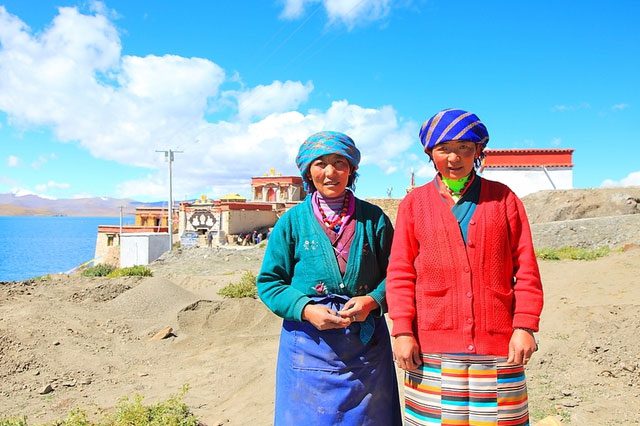Tibet is located on the Qinghai-Tibet Plateau, at an altitude of over 4,000 meters above sea level. As a result, not everyone can adapt to the climatic conditions in Tibet.
However, Tibet is considered a sacred land of China, where many people come for spiritual purification and to admire its famous scenic spots.

Tibet is famous as a sacred land of China. (Photo: Greattibettour).
Among the well-known locations in Tibet, there is a village famous for its harsh living conditions called Tuiwa. This village is situated at the foot of Mount Mongda Kangri, near the shores of Lake Pumoyongcua, at an altitude of 5,070 meters. Tuiwa is also recognized as the highest village in the world. The summer in Tuiwa lasts only a little over two months. Notably, the oxygen levels in the air here are less than half compared to other places.

Tuiwa village is located at an altitude of 5,070m, making it very close to the sun. (Photo: Xinhua).
The name Tuiwa means “connection” in Tibetan. However, this place is not fully connected to the outside world; instead, it remains isolated from it. Transportation in this village is also inconvenient, and living conditions are extremely harsh.
With an altitude of over 5,000m above sea level, it is not easy for people to live long-term here. The population of the village is small, with only a few hundred residents. Notably, the villagers are entirely dependent on agriculture and livestock raising.
Before 2015, no more than 100 tourists visited Tuiwa each year.
Due to the harsh living conditions and low oxygen levels, the average lifespan of the villagers is under 50 years. The local government has attempted multiple times to arrange for them to relocate. However, many do not wish to leave their homeland and choose to stay here.
Being over 5,000 meters above sea level, visitors to Tuiwa can see stars up close. This is also a unique experience that many look forward to when visiting Tibet.
Additionally, weaving is a traditional craft in Tuiwa. Therefore, visitors can easily find weaving looms in the homes of the locals. Moreover, since the residents of Tuiwa live in harmony with nature and do not harm the ecological environment, the beauty surrounding the village remains almost pristine.

The residents of Tuiwa village live a simple and modest life. (Photo: Greattibettour).
The people here lead a simple and humble life. Daily, the young villagers go out to the fields to graze livestock. Meanwhile, only a few children and the elderly stay behind to tend to the homes, which adds to the village’s tranquility. If Tuiwa were not over 5,000 meters high, it would be an ideal retreat for holidays.
During the coldest days of winter, the villagers of Tuiwa often herd their sheep to an island in the center of Lake Puma Yumco. Strangely, while the grass in other nearby pastures withers in the dry season, the grass on this island remains lush. In winter, Lake Puma Yumco is covered by a thick layer of ice, allowing the villagers to herd their sheep across the frozen surface.

The villagers of Tuiwa primarily depend on livestock farming. (Photo: QQ).
After the dry season ends, the villagers will return their sheep before the ice melts. This has been a tradition in this land for thousands of years.
In addition to raising livestock, the villagers of Tuiwa also go to spin prayer wheels in monasteries to pray. Each spring, the villagers hold a Kora ceremony around Lake Puma Yumco, then light incense in the monastery to seek blessings.
When the New Year arrives, the villagers of Tuiwa often cook lamb. This is one of their long-standing traditional dishes.
Due to the high altitude, the population here is sparse. Tuiwa village currently has fewer than 200 residents. The villagers still maintain a nearly primitive living condition. They share livestock management responsibilities equally among themselves. Even candy brought by tourists for the children will be divided according to the number of people in each household.
How does altitude affect the human body?

The residents of Tuiwa have an average lifespan under 50 due to harsh living conditions and lack of oxygen. (Photo: QQ).
According to experts, when the atmosphere is at sea level, human lungs and circulatory systems are optimized for normal functioning. However, as one ascends to higher altitudes, air pressure gradually decreases. Because the air becomes thinner and contains less oxygen, human lungs find it more difficult to breathe.
At an altitude of 2,500 meters, some individuals may experience mild symptoms of oxygen deprivation to the brain. This causes breathing to become rapid and the heart rate to increase to supply oxygen to the body’s organs.
Notably, these issues and symptoms become increasingly severe as one reaches altitudes of 5,500 meters. At this height, oxygen levels in the air are only half of what they are at sea level.
Experts state that when reaching the “Death Zone,” areas with altitudes exceeding 7,600 meters in the atmosphere, humans cannot survive for long due to the lack of oxygen in the thin air. This is also why climbers often experience altitude sickness when ascending to these regions.


















































